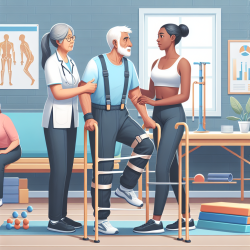Introduction
In the realm of healthcare, the prevention of falls among older adults is a critical area of focus. The research article titled "The Effect of Individualized Fall Prevention Programs on Community-Dwelling Older Adults: A Scoping Review" provides valuable insights into the effectiveness of tailored fall prevention strategies. This blog aims to guide practitioners in enhancing their skills by implementing research findings and encouraging further exploration into individualized fall prevention programs.
Understanding the Research
The scoping review analyzed 32 studies, including 19 controlled trials and 13 quasi-experimental studies, to assess the impact of individualized fall prevention programs. These programs often involve a multidisciplinary approach, with physical therapists playing a significant role in 72% of the studies. The review highlighted the heterogeneity of procedures and outcome measures, with common interventions including balance assessments, individualized exercises, and cognitive evaluations.
Key Findings
- Improvement in fall frequency was observed in 61.5% of controlled trials and 80% of quasi-experimental studies.
- Balance and function improved in 54.5% of controlled trials and 100% of quasi-experimental studies.
- Strength improvements were noted in 43% of controlled trials and 75% of quasi-experimental studies.
Despite the variability in interventions, the review suggests that individualized, multimodal fall prevention programs can effectively reduce fall risk among community-dwelling older adults.
Practical Implications for Practitioners
Practitioners can leverage these findings to enhance their fall prevention strategies. Here are some actionable steps:
- Utilize Multidisciplinary Teams: Collaborate with physical therapists, occupational therapists, and other healthcare professionals to design comprehensive fall prevention programs.
- Focus on Individualization: Tailor interventions to address the unique needs of each older adult, considering factors such as balance, strength, cognition, and environmental risks.
- Incorporate Evidence-Based Assessments: Use validated tools like the Timed Up and Go (TUG) test to assess fall risk and track progress.
- Emphasize Education and Motivation: Educate older adults about fall risks and engage them in motivational interviewing to enhance adherence to prevention programs.
Encouraging Further Research
While the current research provides a foundation, there is a need for further investigation into the optimal components of individualized fall prevention programs. Practitioners are encouraged to contribute to this growing body of evidence by:
- Conducting studies that explore the cost-effectiveness of various intervention strategies.
- Investigating the role of telehealth and remote monitoring in delivering fall prevention programs.
- Exploring the impact of psychosocial factors, such as depression and social isolation, on fall risk.
Conclusion
By integrating the findings from this scoping review into practice, healthcare providers can enhance their ability to prevent falls among older adults. The emphasis on individualized, multimodal programs offers a promising approach to improving outcomes for community-dwelling older adults. Practitioners are encouraged to continue exploring innovative strategies and contribute to the ongoing research in this vital area of healthcare.
To read the original research paper, please follow this link: The Effect of Individualized Fall Prevention Programs on Community-Dwelling Older Adults: A Scoping Review.










